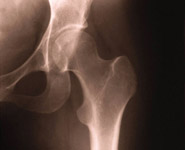Although the use of stemmed MOM hip implants has declined in England and Wales, recent data suggest they are still extensively used in the USA, with 35 per cent of hip replacements using MOM implants in 2009. The use of large-head stemmed MOM implants became popular because it was believed that they reduced the likelihood of dislocation and were highly resistant to wear.
In this study, a team led by Ashley Blom, Professor of Orthopaedic Surgery in the School of Clinical Sciences at the University of Bristol, analysed data from the National Joint Registry of England and Wales including more than 400,000 hip replacements (of which 31,171 were MOM) undertaken between 2003 and 2011 that were tracked for up to seven years after surgery. They estimated failure rates for stemmed MOM implants based on different head sizes and compared them with implants made from ceramic and polythene.
Stemmed MOM failed much more quickly than other types of bearing surface, with a five-year revision rate of 6.2 per cent. Failure was related to head size, with larger heads failing earlier, corresponding to a two per cent increase in the risk of failure for each one mm increase in head size. By contrast, ceramic-on-ceramic implants did better with larger head sizes.
In women, failure rates for stemmed MOM implants were up to four-times higher than those of other bearing surfaces, and were also higher compared with men even with the same head size.
The authors conclude: "Metal-on-metal stemmed articulations give poor implant survival compared with other options and should not be implanted. All patients with these bearings should be carefully monitored, particularly young women implanted with large diameter heads."
In an accompany Comment, Art Sedrakyan from Weill Cornell Medical College, Cornell University, New York, warns of the current situation in the USA: "The National Institutes of Health is interested in new discoveries and, until recently, not in infrastructure for comparative safety and effectiveness. There is also substantial pressure from Congress not to stifle innovation and to undertake faster reviews. [These practices] fail to recognise that only a large national, or even worldwide, registry can address the needs when more than 10,000 products are on the market for the same purpose."
He adds: "Policy makers need to appreciate that registry data alone are not a substitute for good premarketing studies, which should include testing of implants. When failures take a long time to develop, many faulty products can enter the market. In the case of the ASR and metal-on-metal implants it took four-five years before evidence was accumulated and reported. We are left with more than 500 000 patients with metal-on-metal prostheses in USA and more than 40,000 in the UK who are at elevated risk of device failure, which will inevitably result in the burden of further surgical treatment as well as billions of dollars in costs to taxpayers."
Paper: Failure rates of stemmed metal-on-metal hip replacements: analysis of data from the National Joint Registry of England and Wales, Alison J Smith, Paul Dieppe, Kelly Vernon, Martyn Porter, Ashley W Blom; on behalf of the National Joint Registry of England and Wales, The Lancet, published online March 13, 2012.
Media coverage of this study is available at: www.bristol.ac.uk/news/2012/8321.html
